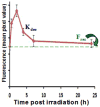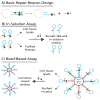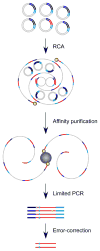Towards precision prevention: Technologies for identifying healthy individuals with high risk of disease
- PMID: 28458064
- PMCID: PMC5841554
- DOI: 10.1016/j.mrfmmm.2017.03.007
Towards precision prevention: Technologies for identifying healthy individuals with high risk of disease
Abstract
The rise of advanced technologies for characterizing human populations at the molecular level, from sequence to function, is shifting disease prevention paradigms toward personalized strategies. Because minimization of adverse outcomes is a key driver for treatment decisions for diseased populations, developing personalized therapy strategies represent an important dimension of both precision medicine and personalized prevention. In this commentary, we highlight recently developed enabling technologies in the field of DNA damage, DNA repair, and mutagenesis. We propose that omics approaches and functional assays can be integrated into population studies that fuse basic, translational and clinical research with commercial expertise in order to accelerate personalized prevention and treatment of cancer and other diseases linked to aberrant responses to DNA damage. This collaborative approach is generally applicable to efforts to develop data-driven, individualized prevention and treatment strategies for other diseases. We also recommend strategies for maximizing the use of biological samples for epidemiological studies, and for applying emerging technologies to clinical applications.
Keywords: Comet; DNA damage; DNA damage response; DNA repair; H2AX; Host cell reactivation; Precision medicine.
Copyright © 2017 Elsevier B.V. All rights reserved.
Conflict of interest statement
J.H.B. has consultancy, stock ownership, and royalties with Grail Inc. B.P.E. is a co-inventor on a patent for CometChip that has been licensed to Trevigen, Inc. R.W.S. is a scientific consultant for Trevigen, Inc.
Figures









Similar articles
-
Inherent and toxicant-provoked reduction in DNA repair capacity: A key mechanism for personalized risk assessment, cancer prevention and intervention, and response to therapy.Int J Hyg Environ Health. 2018 Aug;221(7):993-1006. doi: 10.1016/j.ijheh.2018.07.003. Epub 2018 Jul 21. Int J Hyg Environ Health. 2018. PMID: 30041861 Review.
-
Precancer Atlas to Drive Precision Prevention Trials.Cancer Res. 2017 Apr 1;77(7):1510-1541. doi: 10.1158/0008-5472.CAN-16-2346. Cancer Res. 2017. PMID: 28373404 Free PMC article.
-
The Need for Multi-Omics Biomarker Signatures in Precision Medicine.Int J Mol Sci. 2019 Sep 26;20(19):4781. doi: 10.3390/ijms20194781. Int J Mol Sci. 2019. PMID: 31561483 Free PMC article. Review.
-
Clinical multi-omics strategies for the effective cancer management.J Proteomics. 2018 Sep 30;188:97-106. doi: 10.1016/j.jprot.2017.08.010. Epub 2017 Aug 15. J Proteomics. 2018. PMID: 28821459 Review.
-
Multiplexed DNA repair assays for multiple lesions and multiple doses via transcription inhibition and transcriptional mutagenesis.Proc Natl Acad Sci U S A. 2014 May 6;111(18):E1823-32. doi: 10.1073/pnas.1401182111. Epub 2014 Apr 22. Proc Natl Acad Sci U S A. 2014. PMID: 24757057 Free PMC article.
Cited by
-
CometChip analysis of human primary lymphocytes enables quantification of inter-individual differences in the kinetics of repair of oxidative DNA damage.Free Radic Biol Med. 2021 Oct;174:89-99. doi: 10.1016/j.freeradbiomed.2021.07.033. Epub 2021 Jul 26. Free Radic Biol Med. 2021. PMID: 34324980 Free PMC article.
-
Large-scale preparation of fluorescence multiplex host cell reactivation (FM-HCR) reporters.Nat Protoc. 2021 Sep;16(9):4265-4298. doi: 10.1038/s41596-021-00577-3. Epub 2021 Aug 6. Nat Protoc. 2021. PMID: 34363069 Free PMC article.
-
Development of a high-throughput γ-H2AX assay based on imaging flow cytometry.Radiat Oncol. 2019 Aug 22;14(1):150. doi: 10.1186/s13014-019-1344-7. Radiat Oncol. 2019. PMID: 31438980 Free PMC article.
-
Dynamically monitoring cellular γ-H2AX reveals the potential of carcinogenicity evaluation for genotoxic compounds.Arch Toxicol. 2021 Nov;95(11):3559-3573. doi: 10.1007/s00204-021-03156-3. Epub 2021 Sep 12. Arch Toxicol. 2021. PMID: 34510228
-
Interplay Between Air Travel, Genome Integrity, and COVID-19 Risk vis-a-vis Flight Crew.Front Public Health. 2020 Dec 18;8:590412. doi: 10.3389/fpubh.2020.590412. eCollection 2020. Front Public Health. 2020. PMID: 33392133 Free PMC article.
References
-
- Auerbach C. Chemical Mutagenesis. Biol Rev Camb Philos Soc. 1949;24:355–391. - PubMed
-
- HoIlaender A, Emmons CW. Wavelength dependence of mutation production in the ultraviolet with special emphasis on fungi. Cold Spring Harb Symp Quant Biol. 1941:179–186.
-
- Hollaender A, Baker WK, Anderson EH. Effect of oxygen tension and certain chemicals on the x-ray sensitivity of mutation production and survival. Cold Spring Harb Symp Quant Biol. 1951;16:315–326. - PubMed
-
- Weigle JJ, Bertani G. Multiplicity reactivation of bacteriophage inactivated by ionizing radiations. Virology. 1956;2:344–355. - PubMed
Publication types
MeSH terms
Grants and funding
- U01 ES011038/ES/NIEHS NIH HHS/United States
- R21 ES019492/ES/NIEHS NIH HHS/United States
- R01 ES011740/ES/NIEHS NIH HHS/United States
- Z99 ES999999/ImNIH/Intramural NIH HHS/United States
- P01 CA092584/CA/NCI NIH HHS/United States
- DP1 ES022576/ES/NIEHS NIH HHS/United States
- R44 ES021116/ES/NIEHS NIH HHS/United States
- R01 ES019319/ES/NIEHS NIH HHS/United States
- R44 ES025139/ES/NIEHS NIH HHS/United States
- R01 CA148629/CA/NCI NIH HHS/United States
- R21 ES019494/ES/NIEHS NIH HHS/United States
- P30 ES009089/ES/NIEHS NIH HHS/United States
LinkOut - more resources
Full Text Sources
Other Literature Sources

